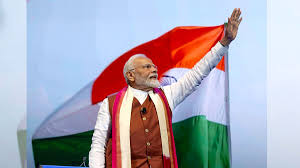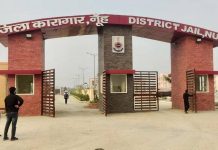As Narendra Modi completes 23 years in governance both at the state and national level, he should count his blessings. Alongside, he must address the demons that could cast a shadow along the way. by KumKum Chadha.

Former Kenyan Prime Minister’s allegations about Prime Minister Narendra Modi and industrialist Gautam Adani’s “close ties” could not have come at a worse time.
The BJP was gung-ho about Prime Minister Modi completing 23 years in public office and his ascent from Gujarat Chief Minister to the country’s Prime Minister: not once but thrice over.
Adept at a publicity blitz, the Party exhorted the people to celebrate PM Modi’s “nation first commitment”.
Till the disclosure from Kenya dampened its spirits.
Former Prime Minister Raila Odinga has admitted that as Chief Minister of Gujarat, Modi had introduced Adani to him. Back home, Odinga is under attack for favoring the Adani group for infrastructure projects in his country.
Nearer home, there were reports of “pressure” from the Modi government on the Sri Lankan Government to hand over a wind energy project to the Adani group.
This was enough ammunition for the Congress Party to train its guns at the Modi government and accuse it of favoring the Adani group.
Charges about the Modi Adani connection have stuck.
The Modi-Adani relationship dates back to 2002 when communal riots had badly damaged Modi’s image as Chief Minister. Adani was among those in the business community in Gujarat that stood by Modi. Later, he helped him organize the Vibrant Gujarat summit that helped showcase Modi as a development icon.
It is but a strange and perhaps an interesting coincidence that the Adani-Modi relationship is just a year short of the 23 years of Modi being in office, both at the state and the Centre.
23 years is a long time: life takes a turn, sometimes for the better and at other times for the worse. There are happy moments and there are pitfalls; there are times you are lauded and there are times you get flak. But you carry on: fighters and warriors don’t quit: whatever be the circumstances.
Nothing can describe Narendra Damodardas Modi’s life better.
It was on October 7, 2021 that Modi was sworn in as Gujarat Chief Minister for the first time. He was not even an MLA then.
His elevation to office was circumstantial. The then Chief Minister Keshubhai Patel’s health was failing and the aftermath of the Bhuj earthquake was staring hard.
The choice to lead the state fell on Modi. He took over and the rest is History: the Gujarat riots being one black mark in his chequered career.
The Courts gave him a clean chit but the scars have remained.
To refresh memory, on February 27, 2002 as many as 58 people died when a coach of Sabarmati Express carrying kar sevaks were burnt alive in Gujarat’s Godhra. They were returning from Ayodhya. This resulted in large scale riots, slated to be among the worst communal violence in India.
As per official estimates, over 1000 people were killed, the majority being Muslims. Allegations of the state government “not doing enough” were doing the rounds and fingers were pointed at its complicity. In the eye of the storm was Narendra Modi.
Undeterred, the man at the helm carried on. His focus: economic development of Gujarat, something which he continued till he headed the state.
Thanks to Modi’s outreach and the Adani push, there was a boom in production; Gujarat topped the world ranking of “ease of doing business”; it also ranked first among all Indian states for “economic freedom”.
Therefore, when Modi ascended to Delhi from Gujarat, he did not carry the Godhra baggage. Rather he was seen as a man who mooted development.
Every leader, who is ambitious and progressive, faces a rocky path. So did Modi, and perhaps continues to do so.
When he was named BJP’s candidate for Prime Minister, ahead of 2014 elections, opposing him was none other than his erstwhile supporter L.K.Advani: the same man who had saved him from being replaced as Chief Minister when Prime Minister Atal Behari Vajpayee was hell bent on showing him the door.
Since then, much water has flown under the bridge. The Vajpayee-Advani era is History. Now, Modi has new opponents to contend with. It is a new journey with demons raising their heads.
But first, the positives.
Even Modi’s bitterest critics cannot deny the path of development that was ushered in during Modi’s three tenures as Prime Minister.
The world has not only started taking India seriously but when Modi speaks, the world leaders sit up and listen. That India has emerged as a force to reckon with under Modi is a given.
Critics may call it BJP’s PR machinery and differ with official statistics and growth figures, but there can be no two opinions of India being in a decisive and dominant position on the world stage.
Even if there is a gap between perception and reality, in Modi’s India, perception scores.
Having said that one cannot take away from him his initiatives in qualitatively improving the lives of ordinary Indians. Which Prime Minister, and even those who came from the not so privileged backgrounds and had battled poverty in their formative years, had thought of building toilets in rural homes? Which Prime Minister had actually ensured money being transferred to an individual’s bank account, particularly women? Which Prime Minister had spoken about replacing chulahs at homes with cooking gas? Yes, there were issues with implementation or gaps in the delivery system but aren’t these initiatives laudable?
Should these be dismissed simply because only some people and not everyone has benefitted?
At the macro level, there are many initiatives the Modi government has taken that one must take note of, the digital initiative being one such.
Add to this, the push to local manufacturing under the Make in India initiative, infrastructure development, the massive government-funded health care programme including health insurance, water and environmental conservation, sports development and poverty alleviation to mention a few.
Against this backdrop one may ask, and of course legitimately: then why did the BJP fail to get a majority on its own in Modi’s third electoral run?
The answers are not there in black and white: nor in one or two sentences. However, the crux seems to be that there is an atmosphere of fear that prevails; the suffocation in certain segments and the absence of free will and speech that has cast a shadow on governance.
Add to this the muzzling of those who are critical of the government’s functioning; erosion of institutions and puppet stringing agencies like the CBI or Enforcement Directorate and everyone would agree that course correction is the only way forward.
But a course correction is not the same as being written off. Yes, the recent general election results are a warning for the BJP and a stern message that personal liberty in this country cannot and should not be jeopardized.
For those casting their votes, it is not a trade-off between development and liberty and the freedom to speak one’s mind.
Not only should these go hand in hand but in a vibrant democracy like India, freedom and liberty must get precedence.
As things stand, under Modi, India’s growth story is well scripted. Yet there are contours which should be chiseled and fine tuned: the colours are, perhaps, right but the blend needs to be corrected.
As Modi reaches a historic milestone of completing 23 years in governance both at the state and national level, he should count his blessings. Alongside, he must address the demons that could cast a shadow along the way.












